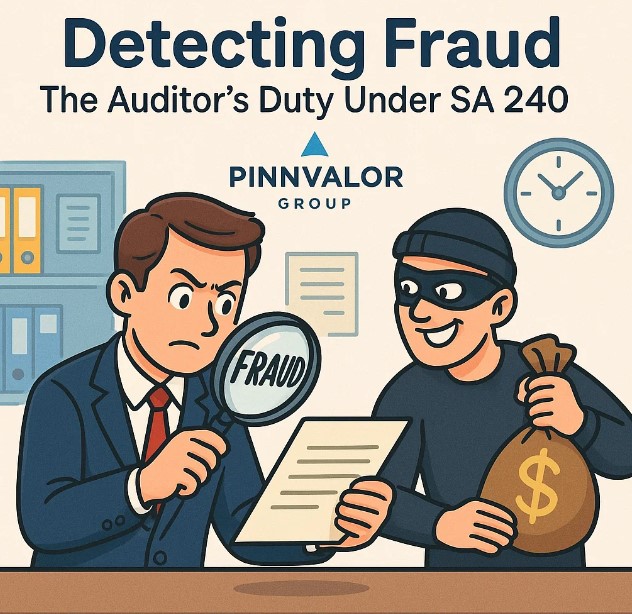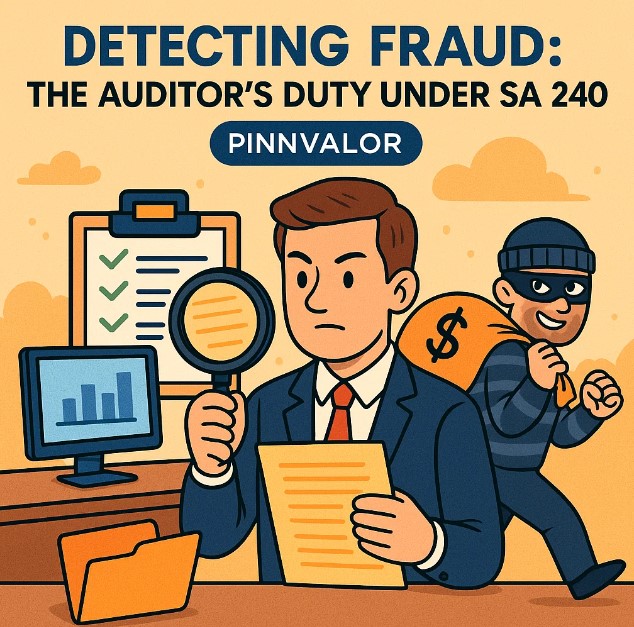
Detecting Fraud: The Auditor’s Duty Under SA 240
Fraud poses a serious threat to the integrity of financial reporting and can have devastating effects on businesses, stakeholders, and the economy at large. Recognizing this risk, the auditing standard SA 240 – The Auditor’s Responsibilities Relating to Fraud in an Audit of Financial Statements lays out a comprehensive framework that defines the auditor’s role in detecting and responding to fraud. This blog explores SA 240 in depth, highlighting the responsibilities, limitations, and expectations placed on auditors in combating financial fraud.
Can auditors truly detect fraud, or are they just scratching the surface?
Auditors aren’t detectives—but SA 240 demands they think like one. Professional skepticism is their most powerful tool against deception.
What Is SA 240?
SA 240, issued by the Institute of Chartered Accountants of India (ICAI), is aligned with the International Standard on Auditing (ISA) 240. It aims to establish standards and provide guidance on the auditor’s responsibilities regarding fraud in an audit of financial statements.
The standard emphasizes that while the primary responsibility for preventing and detecting fraud rests with management and those charged with governance, auditors are expected to maintain professional skepticism and design audit procedures that address the risk of material misstatement due to fraud.
Defining Fraud Under SA 240
SA 240 identifies fraud as an intentional act by one or more individuals among management, employees, or third parties involving the use of deception to obtain an unjust or illegal advantage. It categorizes fraud into two main types:
- Fraudulent Financial Reporting – Intentional misstatements or omissions in financial statements, such as manipulation of accounting records, misrepresentation of facts, or omission of significant information.
- Misappropriation of Assets – Theft or misuse of an entity’s assets, for example, embezzlement, payroll fraud, or unauthorized use of company resources.
Key Responsibilities of the Auditor Under SA 240
1. Maintaining Professional Skepticism
Auditors must remain skeptical throughout the audit process. This means:
- Not assuming that management is honest or dishonest.
- Recognizing the possibility of fraud even when past audits have revealed no issues.
- Being alert to conditions that may indicate possible misstatement due to fraud.
2. Understanding the Entity and Its Environment
Auditors should gain insight into the organization’s operations, internal controls, and industry conditions to:
- Identify risk factors.
- Assess how fraud could occur.
- Evaluate the tone at the top (ethical culture).
3. Assessing the Risk of Material Misstatement Due to Fraud
This includes:
- Performing risk assessment procedures such as inquiries, analytical procedures, and observation.
- Identifying incentives, pressures, and opportunities for fraud.
- Considering the risk of override of controls by management.
4. Designing and Performing Audit Procedures
Once fraud risks are identified, auditors must tailor audit procedures to respond to these risks. This might involve:
- Performing more substantive testing.
- Reviewing journal entries and accounting estimates.
- Evaluating the business rationale of significant unusual transactions.
5. Evaluating Audit Evidence
Auditors must continually assess whether evidence obtained supports the financial statements. If inconsistencies or unusual relationships arise, they must be investigated thoroughly.
6. Communicating Fraud or Suspected Fraud
When fraud is detected or suspected:
- It must be communicated to management and, when appropriate, those charged with governance.
- If fraud involves senior management or results in a material misstatement, auditors are obliged to report it directly to those charged with governance.
- In some cases, auditors may have a duty to report the matter to regulatory or enforcement authorities.

Limitations of the Auditor’s Role
Despite these responsibilities, it’s important to recognize the inherent limitations of an audit in detecting fraud:
- Collusion among employees or with third parties can make fraud difficult to detect.
- Override of controls by management may conceal fraudulent activities.
- Audits are conducted on a test basis, not every transaction is examined.
- Auditors are not trained as fraud investigators; their role is to form an opinion on the truth and fairness of financial statements.
Therefore, SA 240 clarifies that an audit is not designed to detect all fraud—only those that result in material misstatements of the financial statements.
Best Practices to Strengthen Fraud Detection
To enhance the effectiveness of audits in detecting fraud, auditors and organizations should adopt the following practices:
- Strong internal controls and a fraud risk management framework.
- Whistleblower mechanisms for employees to report suspicious behavior.
- Regular training for audit teams on fraud detection techniques.
- Effective governance and an ethical corporate culture.
Conclusion
SA 240 serves as a crucial guidepost for auditors in navigating the complex and sensitive area of fraud detection. While the standard acknowledges that auditors cannot guarantee the detection of all fraud, it places a firm responsibility on them to approach audits with skepticism, diligence, and a structured methodology. Ultimately, it reinforces the broader goal of promoting transparency, trust, and accountability in financial reporting.
By understanding and applying SA 240 effectively, auditors not only uphold professional standards but also contribute meaningfully to the fight against financial fraud.
